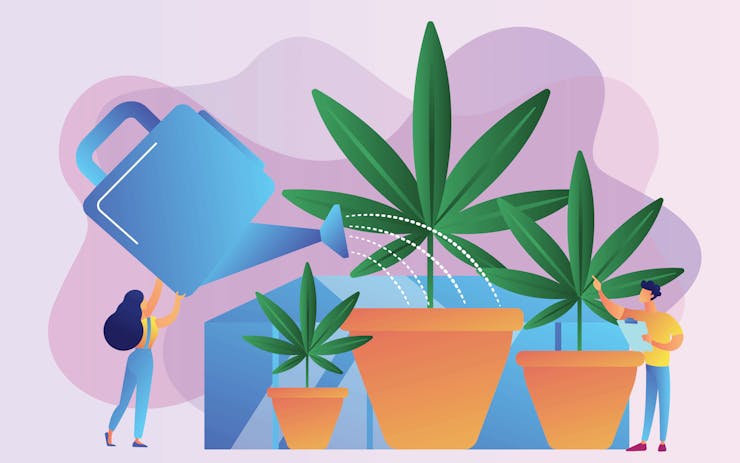The diversity of cannabis genetics is increasing with every new phenotype that pops up. As legal markets with data and analytics illustrate what consumers are buying, a sea change is brewing in what traits cultivators are seeking in their plants.
Yield, potency, and hardiness used to be primary concerns, but craft cultivation now is pristine flower and more—it’s about hyper-fragrant nose notes, intense flavor expressions on the palette, rare terpenes and cannabinoids, and in some cases, practical reasons like easier harvesting or soil stewardship.
Leafly asked four cannabis producers to discuss breeding insights and find out exactly what they are looking for in plants.
A lingering taste
Pete Pietrangeli, product development manager with Indus Holdings, founder of Acme Premium Vapes, and LA Confidential dispensary, is involved with all steps of the business, from genetics to vape production.
Based in Salinas, California, his grow runs on a combination of sun and power, but it’s too large to function as an indoor operation. Live resin, terp sauces, and boutique extracts are their thing, and those have to come from perfect flower.
That means lots of crossbreeding to find the best traits. “This is what has led many growers to breeding their own seeds with special traits that can endure various climates. For example, crossing white widow into popular strains was widely used in the Hawaiian islands, to combat mold and mildew which White Widow is very resilient to,” says Pietrangeli.
Flavor can often be temporary in cannabis products, hitting the nose but not the mouth in the smoke or vapor. Their Lemon Cake live resin is one of the rarest expressions they’ve ever been able to achieve. “It is definitely rich in limonene, however, it has a different smooth finish that doesn’t just give you a taste and ends abruptly but lingers on in your taste buds,” he says.
Using other plants for terpenes
Cyril Guthridge of Waterdog Herb Farm in California’s Mendocino County doesn’t just grow cannabis on his lush piece of mountainside. As a working herb farm in addition to a cannabis grow, the symbiosis of dozens of plant species and animals is at play—and they influence their cannabis as well.
“We like to plant high-terpene plants near our cannabis and feed our [cannabis] other terpene-rich plants. We have seen great results from our trials and experiments with this,” says Guthridge.
With plants like qinghao, a.k.a. wormwood, and lavender brushing stalks with the huge, sun grown crop, Guthridge’s land is producing some really unique cannabis flower.
“This year we have a few very special terpenes we are excited about. One is from a ‘Galicot’ from StaeFli Farms,” he says. “It smells like fresh mint cookies with a drizzle of skunky garlic sauce.”
Waterdog Farms has no trouble getting big buds, but they’re all about results, not quantity. “I will always choose to grow a unique cultivar over a large yield any day,” says Guthridge. “I’m not interested in growing the biggest plant. I want to explore the nuances of the genetics within the profiles it has and help express those qualities through our cultivating techniques.”
Flavonoids and resistance to drought
CEO and founder of Endo Industries, Nancy Do, has a unique approach to coaxing the best out of her plants. Endo designs and produces healthy cannabis clones in Northern California, and they are thinking a few steps ahead to help farmers get there too.
“We do spend a lot of our time at the moment just creating and engineering pathogen- and disease-free plants for growers, which is such a huge feat in itself,” says Do. But she is the first to admit how vast the future of cannabis genetics is looking, especially when looking past the high-THC breeding rush of the past 10 years and into the other compounds in cannabis.
“Aside from terpenes, we’re definitely looking into flavonoids, and other secondary metabolites. It’s not just that there’s medicinal purposes and that they express these amazing things in the plant that we enjoy consuming, it’s also that it helps the plant become stronger and more vigorous,” says Do.
Cannaflavins are big on Do’s list of exceptional traits to look for, as a set of flavonoids exclusive to cannabis could have anti-inflammatory properties. And there’s still more research to come that can be applied to cannabis genetics.
As people depend more and more on cannabis for medicine, preserving it is a goal for Do and her company. “Ultimately, we have to think about heat tolerance and heat resistance, as well as drought tolerance, because global warming is accelerating. Farmers across the board have to think about this, breeders have to think about this,” says Do.
This is scary stuff, but Do thinks it’s time to be realistic. “What was viable in their climate now or even five years ago will be different in five more years at the rate we are going,” she says.
Workability of the product
Pieter Summs, lead grower at Oregon’s Otis Gardens, runs an indoor operation that’s up-to-date with cannabis’ evolving requirements. Part of this involves introducing physical traits to a genetics program, which Summs says, ”Allow for easy workability of the product, such as a high calyx-to-leaf ratio for easy trim-ability of the flowers and easy maintenance of the live plant.” These adjustments make the plant do well in close quarters as well as make harvesting more simple.
As for the unique flavors and scents, Summs shouts out their own strain, Dethman Ridge Skunk. “Her off-fruity smell evolves from around week six, a room of Dethman is undeniable from yards outside. Rock hard flowers offer a slightly savory smell the further into flower she progresses,” he says.
No matter what a cannabis producer is coaxing out of their creations, it all adds up to a better product in your pocket. We’re only just now seeing the landscape reveal itself from the fog of prohibition, so there are decades of genetics experiments to come, and most importantly, to learn from.






